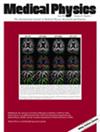Overcoming the thermal limits of photon counting CT resolution using focal spot multiplexing: A feasibility study
Abstract
Background
The spatial resolution of new, photon counting detector (PCD) CT scanners is limited by the size of the focal spot. Smaller, brighter focal spots would melt the tungsten focal track of a conventional X-ray source.
Purpose
To propose focal spot multiplexing (FSM), an architecture to improve the power of small focal spots and thereby enable higher resolution clinical PCD CT. In FSM, the source rapidly alternates between multiple focal spot locations. The dwell time at each focal spot location is much shorter than the readout interval of the PCD, and each location is visited many times during the readout interval so that heat can be effectively distributed over a larger surface area. The PCD accumulates recorded events on the detector (prior to slip ring transmission) into multiple spatial bins, as a second dimension to conventional energy bins.
Methods
We estimated the maximum power permissible for a square, 0.2 mm focal spot assuming a maximum allowed surface temperature of 2900 K and a maximum transient temperature increase at the focal spot of 1400 K. This was performed using two separate thermal simulation codes: first, a commercial finite element method (FEM) was used to estimate bulk heating; second, a custom solver linearizing the heat equation was used to estimate track heating. FSM was simulated assuming that focal spot locations lay on parallel focal tracks, that instantaneous switching between tracks was possible, and that the space charge limit was never reached. We assumed a focal track velocity of 100 m/s and a 1 mm tungsten focal track layer with TZM alloy backing. The tube power was constant over a 4 s acquisition period.
Results
Without FSM, the 0.2 mm focal spot could attain a maximum power output of 17 kW before reaching the thermal limit. FSM required a minimum switching frequency of 0.5 MHz to produce benefit. With two focal tracks and a switching frequency of 4 MHz, the power could be increased to 28 kW, and with eight focal tracks and a switching frequency of 16 MHz, the power could be increased to 98 kW. In all cases, the 1400 K transient increase thermal limit was reached before the 2900 K maximum surface temperature constraint. The relationship between maximum power, switching frequency, and number of focal tracks is discussed in relation to the underlying physics of heat transport.
Conclusions
Focal spot multiplexing is an architecture that exploits the digital nature of photon counting to improve the power of high-resolution CT X-ray sources. With fast switching and several parallel focal tracks, it may be possible to halve the size of the focal spot while maintaining source power. This work motivates the development of new source technologies that can achieve fast electronic switching.

 求助内容:
求助内容: 应助结果提醒方式:
应助结果提醒方式:


